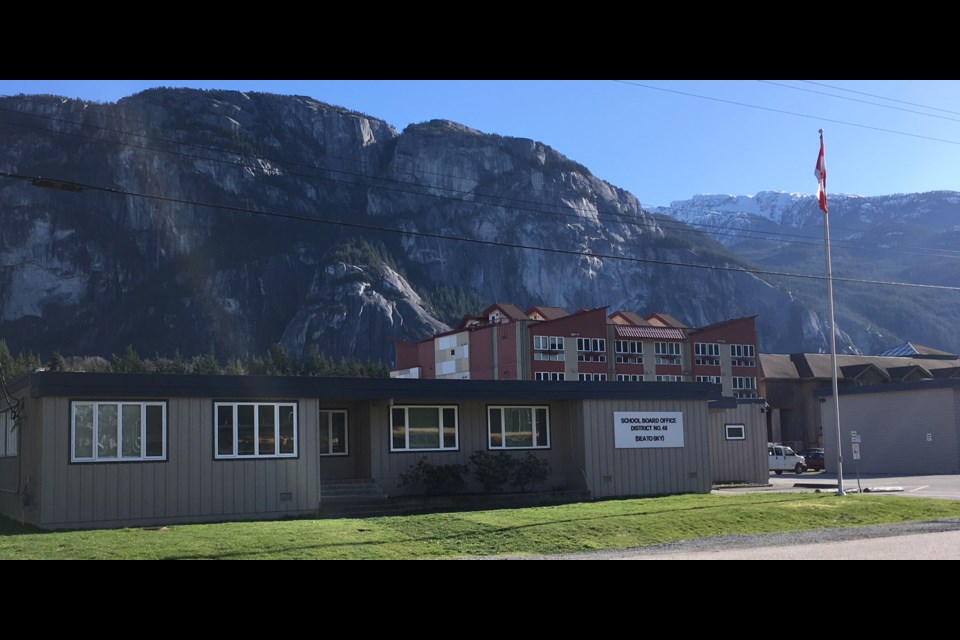Mom Olga Segovia recently drove up from Vancouver, arriving in Squamish at 5 a.m..
She wasn’t up that early for a day on the mountain or for some amazing retail sale.
She was lining up for French Immersion registration at Squamish Elementary.
Segovia and her family will be moving to the district by the start of the next school year and she wants her child in the immersion program.
When she arrived, four parents were already in line, she says.
The line up experience was a good one, according to Segovia, who said she would do it again in a heartbeat.
“We were joking, sleep-deprived parents full of joy, full of pride, eager to show our kids that life is full of sacrifices, risks and choices that you have to make in order to keep growing,” Segovia told The Chief.
A recent review of the immersion program was presented to the Sea to Sky School District (SD48) board on Wednesday evening.
On the table were the options to drop French Immersion as a program of choice, discontinue some of the programming, expand the programming or maintain the existing immersion programming.
Supt. Lisa McCullough recommended maintaining the existing program.
“I can’t see a reasonable way to reduce it,” she told The Chief before the board meeting. “I can’t see any way of managing an increase. We simply couldn’t staff it.”
The board voted at its meeting Wednesday to continue the program and add a clause to work to find creative solutions to the the challenges the review highlighted, including staff shortages and the perceived divisiveness of the program.
There are two camps within the school district when it comes to French Immersion, McCullough said.
“There’s a camp that is very excited about French Immersion. They love the language and culture programing and they see it as rigorous… and lots of families thought it was enriching,” she said, explaining the increased interest in the French programming in the Sea to Sky.
“The other camp would say that French Immersion is divisive. That it creates streaming in secondary schools and a cultural and social divide in elementary schools and they feel very passionately that needs to change.”
Early French immersion — starting in Kindergarten or Grade 1 — was introduced first in Squamish in September of 2014 and is well attended locally, according to the report presented to the board.
Last school year, there were a total of 922 students enrolled in French immersion programs in the district. This year there are 1,030.
In 2017, Squamish had 676 students attending French Immersion out of the total of 1,030 immersion students.
The number of students enrolled in the program in Squamish has increased each year it has been offered.
Every student who wanted early immersion got a spot, according to McCullough.
In 2016, 614 Squamish students were in immersion, and in 2015 there were 505.
At Squamish Elementary there are more French classes than English, according to the report.
Late French Immersion has been a part of the school system in the corridor for 31 years and is currently offered at Squamish Elementary, Don Ross Middle School, Howe Sound Secondary and at Whistler schools Spring Creek elementary, Signal Hill Elementary, Whistler Secondary and in Pemberton at Pemberton Secondary.
Challenges
Though the school district has been able to fill all French Immersion positions, it is difficult to attract and maintain staff to support the immersion program, according to the report.
Nationally, school districts are currently struggling to fill all their French Immersion teaching positions, the report notes.
“We go to Ontario and Quebec to do career fairs,” said McCullough, explaining that the Sea to Sky school district does relatively well attracting teachers. “French people love the mountains so I think that is one of the reasons we do well.”
The cost of housing in the district also contributes to the challenges in retaining staff that are being felt across Canada, McCullough added.

Sustainability
There is little room to grow French immersion in the Sea to Sky Corridor, the report states.
In Squamish, there are current space issues at Garibaldi Highlands and Squamish elementary schools, “which are exacerbated by their high enrollment in French immersion,” the report states.
“As space in schools in Squamish fills to capacity and beyond, the impact of the significant French Immersion enrollment at both Squamish Elementary and Garibaldi highlands Elementary will need to be monitored.”
McCullough recommended that the board consider the situation as part of its upcoming spring facilities and enrollment review for Squamish.
In terms of Whistler, its Whistler Secondary School is full to capacity. Spring Creek Community School has the immersion program for Whistler and is predicted to be at capacity for in the next few years.
In Pemberton, both schools have room for their current late immersion program, but not for any growth in the program.
“The parents in the north, some of them want early French Immersion and from my point of view that is not on the table,” McCullough said. “There is just no I could get staff up in Pemberton and Whistler for five grades at two schools.”
The English/French divide
McCullough said the French immersion program has lead to some division in the district between children who attend the program and those who don’t. [#4]
“District staff have received ongoing anecdotal comments over time related to the divisive nature of dual track programming,” reads the report. This anecdotal information was backed up by many responses heard during the review process, McCullough said.
She said the divisiveness of the program is felt more in the northern schools because they are smaller.
~With files from Steven Chua



